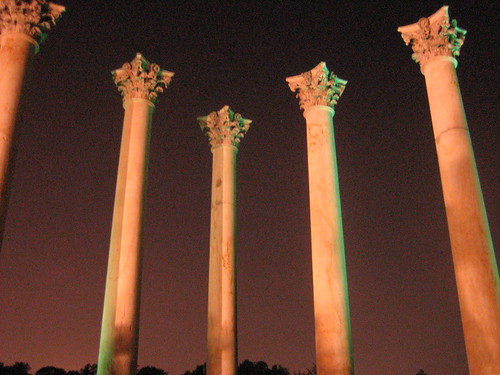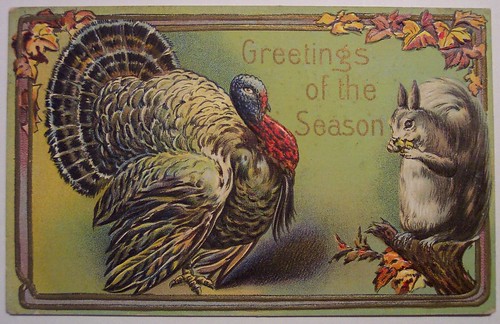We're headed to Florida to visit family for a week, then to Costa Rica until January 13. Expect a lighter posting schedule, though we've queued up a few things for our absence.
Meanwhile, now's your chance to catch up on previous posts on the Natural Capital. The left sidebar lists some of our all-time most popular posts; up above you'll find a navigation bar that sorts posts into various categories.
Have any ideas for how to improve navigation on our site? Leave a comment and let us know.
Thursday, December 24, 2009
Tuesday, December 22, 2009
End-of-Year Giving: Local Conservation Organizations Need Your Help
Like many families, charitable organizations have taken a big hit during this recession. If you can afford it, local groups need your help now more than ever. As we've been reviewing our donation plans for the end of the year, we thought we'd pass along the local environmental organizations that get our support.
Potomac Conservancy - So many of the places we love are located along the Potomac River. The Potomac Conservancy is does hands-on work to address the river's many challenges through clean-ups and restoration projects, as well as fighting for the Potomac in the policy arena.
Anacostia Watershed Society - The Potomac may be ailing, but the Anacostia has historically been the Potomac's neglected cousin. AWS has been changing that, through restoration and protection. Their education efforts have gotten thousands of area kids out on the river.
Chesapeake Bay Foundation - As go our rivers, so goes the Chesapeake Bay. CBF has been working since 1967 to Save the Bay and its tributaries, which drain a 64,000 square mile watershed.
Potomac Appalachian Trail Club - PATC maintains not only our local stretch of the Appalachian Trail but many miles of other trails in our area (including trails in Rock Creek Park), a network of great cabins, and a full schedule of group hikes.
Chesapeake Climate Action Network - CCAN is a grassroots group that brings climate change home on the local level. We give them more than cash - Matt will be jumping in the Chesapeake Bay in January at their Polar Bear Plunge. Sponsor him here, or sign up to join him!
Sierra Club - At 1.3 million members, the Sierra Club is the largest environmental organization in the US. But it's a local organization too, involved in many very local issues. When you donate to the national Sierra Club, you automatically become a member of your local chapter. But you can also donate directly to your chapter in DC, Maryland, or Virginia.
The local Catalogue for Philanthropy has featured some of these groups and many others on its Featured Nature Nonprofits list.
Which groups do you like to support? Make your case in the comments.
Potomac Conservancy - So many of the places we love are located along the Potomac River. The Potomac Conservancy is does hands-on work to address the river's many challenges through clean-ups and restoration projects, as well as fighting for the Potomac in the policy arena.
Anacostia Watershed Society - The Potomac may be ailing, but the Anacostia has historically been the Potomac's neglected cousin. AWS has been changing that, through restoration and protection. Their education efforts have gotten thousands of area kids out on the river.
Chesapeake Bay Foundation - As go our rivers, so goes the Chesapeake Bay. CBF has been working since 1967 to Save the Bay and its tributaries, which drain a 64,000 square mile watershed.
Potomac Appalachian Trail Club - PATC maintains not only our local stretch of the Appalachian Trail but many miles of other trails in our area (including trails in Rock Creek Park), a network of great cabins, and a full schedule of group hikes.
Chesapeake Climate Action Network - CCAN is a grassroots group that brings climate change home on the local level. We give them more than cash - Matt will be jumping in the Chesapeake Bay in January at their Polar Bear Plunge. Sponsor him here, or sign up to join him!
Sierra Club - At 1.3 million members, the Sierra Club is the largest environmental organization in the US. But it's a local organization too, involved in many very local issues. When you donate to the national Sierra Club, you automatically become a member of your local chapter. But you can also donate directly to your chapter in DC, Maryland, or Virginia.
The local Catalogue for Philanthropy has featured some of these groups and many others on its Featured Nature Nonprofits list.
Which groups do you like to support? Make your case in the comments.
Monday, December 21, 2009
Natural Happenings: Take a Break from the Holidays
There's nothing like spending time in nature to recharge from visiting relatives, rampant consumerism, and the 501st replay of "Deck the Halls." The schedule's a little light this week, what with the big holiday and all. Still, there's something on our calendar almost every day. Some highlights:
Tuesday night, there's jazz at the US Botanic Garden on the Mall from 6 to 8. If you haven't seen their cool "storybook garden" of fairy houses made of natural materials yet, you should.
Friday (also known as Christmas), the Center Hiking Club is leading an easy-to-moderat
Things pick back up on Saturday and Sunday with hikes to Manassas Battlefield, Reston Lakes, Tuckahoe State Park, and the Billy Goat Trail -- plus plenty of birding. Check it out.
Tuesday night, there's jazz at the US Botanic Garden on the Mall from 6 to 8. If you haven't seen their cool "storybook garden" of fairy houses made of natural materials yet, you should.
Friday (also known as Christmas), the Center Hiking Club is leading an easy-to-moderat
Things pick back up on Saturday and Sunday with hikes to Manassas Battlefield, Reston Lakes, Tuckahoe State Park, and the Billy Goat Trail -- plus plenty of birding. Check it out.
Friday, December 18, 2009
Links: Solstice Edition
I've always thought of the solstice as the shortest day of the year. It is that, but astronomers actually determine the moment of solstice -- which, this year, will be Monday at 12:45 PM. It's the exact time out of the entire year when the Earth's axis is most inclined away from the sun. Enjoy your lunch!
Other things that caught our eye this week:
Other things that caught our eye this week:
- Capital Weather Gang (our favorite weather forecasters) are now predicting a 100% chance of snow on Saturday.
- Mike Tidwell says -- To fix climate change, stop going green.
- I really believe in drinking tap water, but stories like this NY Times article about water polution are starting to make me wonder. What do you drink?
- Christmas shopping this weekend? Check out our list of Noteworthy Books About Nature in 2009
- USGS is replacing its paper topographic maps with free online ones. I'm a sucker for a good map.
- Clean Currents will look at a Google Map view of your house and tell you whether solar might be feasible on your property. They pointed out to us that while our house is well-shaded, we've got a large, full-sun shed roof to work with. Stay tuned.
- A reminder to use old Christmas trees to protect birds.
- A reminder from Nature Observer to Celebrate Winter.
Interest in the changing seasons is a much happier state of mind than being hopelessly in love with spring. -- Santayana
Thursday, December 17, 2009
LOOK FOR: Holly, a Symbol in Winter Long Before Christmas
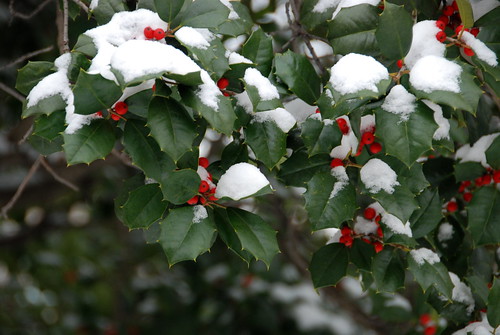 Decking the halls with boughs of holly is a tradition that pre-dates Christmas by quite a while. Romans used holly as a decoration and a gift for Saturnalia, a festival that took place around the winter solstice. Similarly, the Celts would place boughs around their house in the winter for protection and good luck. These traditions were absorbed by the Christian church, and holly became a common Christmas decoration.
Decking the halls with boughs of holly is a tradition that pre-dates Christmas by quite a while. Romans used holly as a decoration and a gift for Saturnalia, a festival that took place around the winter solstice. Similarly, the Celts would place boughs around their house in the winter for protection and good luck. These traditions were absorbed by the Christian church, and holly became a common Christmas decoration. Although decorating with holly started as a European tradition, hollies are native to North America as well. Many species are quite different from our classic idea of a holly tree -- some lose their leaves, some have black berries. But Ilex opaca, known as American holly, has the distinctive spiny, evergreen leaves and bright red berries that have been treasured as a winter decoration for millenia. Early colonists noticed them, too, and holly became an entrenched symbol of Christmas in North America.
 Holly berries are important food for birds, but poisonous to humans. Birds tend to wait a while into the winter before they start eating them -- repeated freezing and thawing can soften them up and make them more palatable. Meanwhile, we get to enjoy their decoration in the woods. The trees are dioecious -- meaning each tree is either male or female. At this time of year, if you spot a holly without berries, there could be several explanations: 1) it's a male; 2) it's a female without a male nearby; 3) its berries have been completely devoured relatively early in the season, or 4) it doesn't get enough light to set fruit.
Holly berries are important food for birds, but poisonous to humans. Birds tend to wait a while into the winter before they start eating them -- repeated freezing and thawing can soften them up and make them more palatable. Meanwhile, we get to enjoy their decoration in the woods. The trees are dioecious -- meaning each tree is either male or female. At this time of year, if you spot a holly without berries, there could be several explanations: 1) it's a male; 2) it's a female without a male nearby; 3) its berries have been completely devoured relatively early in the season, or 4) it doesn't get enough light to set fruit. In the wild: Ilex opaca is scattered throughout the woods of the Washington, DC region. They can grow up to 40 feet, but it's more common to see shorter trees. Now is a great time to spot them, because the evergreen leaves will stand out when other trees have lost their foliage.
In your yard: Holly is a great addition to a yard: for winter interest, habitat value, and as an evergreen screen. They prefer acidic soil. European and asian species are also sold in nurseries; ask for the native Ilex opaca. Compared to imported species, the native should have the most wildlife value -- although birds will eat the berries of most species, insects that have evolved relationships with the leaves of the native may not be able to survive off imports. And those insects serve as more bird food, throughout the year.
Like the photos in this post? Mouse over for credits; a click takes you to the photographer on Flickr.
Tuesday, December 15, 2009
The 110th Annual Christmas Bird Count Has Begun!
 For over 100 years, volunteers have been braving the cold to spend a December day outside counting birds. It's the longest continually running wildlife-monitoring program in the world. Their data has become an invaluable resource for conservationists wanting to track bird populations, and an example for other groups looking to conduct "citizen science."
For over 100 years, volunteers have been braving the cold to spend a December day outside counting birds. It's the longest continually running wildlife-monitoring program in the world. Their data has become an invaluable resource for conservationists wanting to track bird populations, and an example for other groups looking to conduct "citizen science." It all began at the turn of the 20th century when Frank Chapman, an officer in the then-new Audubon Society, proposed an alternative to the Christmas "Side Hunt." He was concerned that this tradition of holiday hunting competitions (in which revelers chose sides and sought to shoot more birds and other animals than the other team) was harming bird populations. At Chapman's suggestion, the 1900 Christmas Bird Census took place in 25 locations, with 27 participants.
From that humble beginning, the Christmas Bird Count has expanded to over 2,000 events and 55,000 participants. Each local group picks a date between December 14 and January 5 to do their count, following a specific methodology developed by the Audubon Society. Birders of all levels are welcome; beginning birders are placed in a group with at least one experienced birdwatcher. Counts often culminate in a "tally rally" at the end of the day that involves food and drink with other counters, the modern equivalent of the bragging party that surely accompanied the original "side hunts."
Interested in participating? The Washington, DC, Bird Count will be this Saturday, December 19. Contact Larry Cartwright at prowarbler@verizon.net or Kathy Wilson at the Audubon Naturalist Society, 301-652-9188, to sign up and get your instructions.
Other local counts (and their organizers) include:
Sunday, December 20:
- Jug Bay (Sam Droege, 301-390-7759, sdroege@usgs.gov)
- Seneca (Mark England, 240-252-4218, markengland@canamcontractors.com)
- Port Tobacco (Gwen Brewer, 301-843-3524, glbrewer@comcast.net)
- C&O Canal near Whites Ferry in Central Loudon County (Joe Coleman, 540-554-2542)
- Nokesville (Kim Hosen, 703-499-4954, khosen@pwconserve.org)
- Patuxent River (Andy Brown, 410-535-5327, brownaj@co.cal.md.us)
- Fort Belvoir (MD - Carol Ghebelian, 301-753-6754. VA - Kurt Gaskill, 703-768-2172 or kurtcapt87@verizon.com)
- Sugarloaf Mountain (Janet Millenson, 301-983-9337, janet@twocrows.com)
Can't make it to one of these events? Stay tuned for the Great Backyard Bird Count, February 12-15!
Like the photos in this post? Mouse over for credits; a click takes you to the photographer on Flickr.
Monday, December 14, 2009
Natural Happenings: Nature-Themed Light Displays
With long winter nights, we all enjoy a little sparkle. Christmas is the focus of most light displays at this time of year, but there are at least two impressive shows whose focus is primarily nature, not holidays.
Any others we should know about?
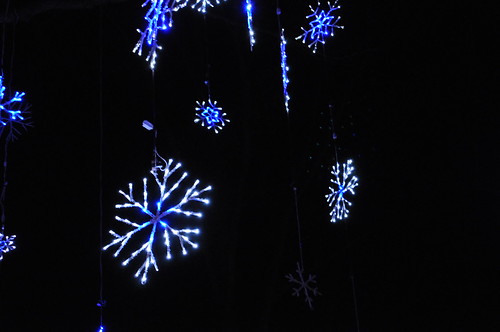 Brookside Gardens in Wheaton, MD offers their Garden of Lights from 5:30 to 9:00 most nights through January 3 (not December 24 or 25).This huge display has hundreds of flowers, trees, animals (including a persimmon-eating giraffe and a walk-through caterpillar tunnel), topped by a delightful rainbow with rain clouds and lightning. This video from Washington Gardener gives a feel for part of the display. They've also got a toy train running through the conservatory, and live music every night in the visitor's center. Although this is a walk-through display, admission is per-car: $15/car Mon-Thur and $20/car Fri-Sun (cash only).
Brookside Gardens in Wheaton, MD offers their Garden of Lights from 5:30 to 9:00 most nights through January 3 (not December 24 or 25).This huge display has hundreds of flowers, trees, animals (including a persimmon-eating giraffe and a walk-through caterpillar tunnel), topped by a delightful rainbow with rain clouds and lightning. This video from Washington Gardener gives a feel for part of the display. They've also got a toy train running through the conservatory, and live music every night in the visitor's center. Although this is a walk-through display, admission is per-car: $15/car Mon-Thur and $20/car Fri-Sun (cash only).
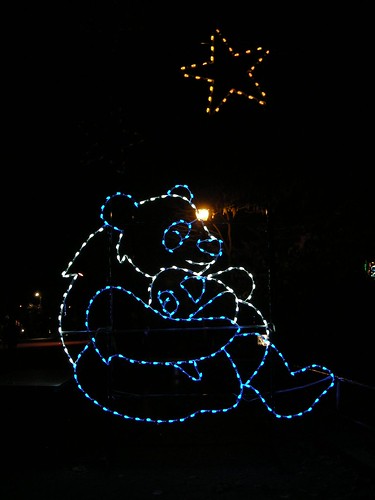 At the National Zoo, ZooLights not only offers thousands of sparkling lights in animal-themed displays, but also keeps some of the animal houses open into the evening, and offers puppet shows and other entertainment. Their website has a slideshow from the 2008 display. Starting Friday, ZooLights will be open from 6:00 to 8:30 most nights, through January 2 (not December 24, 25, and 31). Tickets are $8 per person at the Zoo ($5 for FONZ members) or you can order ahead through Ticketmaster for an additional $3 per ticket. Free for military families on many nights.
At the National Zoo, ZooLights not only offers thousands of sparkling lights in animal-themed displays, but also keeps some of the animal houses open into the evening, and offers puppet shows and other entertainment. Their website has a slideshow from the 2008 display. Starting Friday, ZooLights will be open from 6:00 to 8:30 most nights, through January 2 (not December 24, 25, and 31). Tickets are $8 per person at the Zoo ($5 for FONZ members) or you can order ahead through Ticketmaster for an additional $3 per ticket. Free for military families on many nights.
As always, we've got a full calendar of group hikes and other activities going on this week in parks around the DC area. We'll see you out there!
Like the photos in this post? Mouse over for credits; a click takes you to the photographer on Flickr.
Any others we should know about?
 Brookside Gardens in Wheaton, MD offers their Garden of Lights from 5:30 to 9:00 most nights through January 3 (not December 24 or 25).This huge display has hundreds of flowers, trees, animals (including a persimmon-eating giraffe and a walk-through caterpillar tunnel), topped by a delightful rainbow with rain clouds and lightning. This video from Washington Gardener gives a feel for part of the display. They've also got a toy train running through the conservatory, and live music every night in the visitor's center. Although this is a walk-through display, admission is per-car: $15/car Mon-Thur and $20/car Fri-Sun (cash only).
Brookside Gardens in Wheaton, MD offers their Garden of Lights from 5:30 to 9:00 most nights through January 3 (not December 24 or 25).This huge display has hundreds of flowers, trees, animals (including a persimmon-eating giraffe and a walk-through caterpillar tunnel), topped by a delightful rainbow with rain clouds and lightning. This video from Washington Gardener gives a feel for part of the display. They've also got a toy train running through the conservatory, and live music every night in the visitor's center. Although this is a walk-through display, admission is per-car: $15/car Mon-Thur and $20/car Fri-Sun (cash only). At the National Zoo, ZooLights not only offers thousands of sparkling lights in animal-themed displays, but also keeps some of the animal houses open into the evening, and offers puppet shows and other entertainment. Their website has a slideshow from the 2008 display. Starting Friday, ZooLights will be open from 6:00 to 8:30 most nights, through January 2 (not December 24, 25, and 31). Tickets are $8 per person at the Zoo ($5 for FONZ members) or you can order ahead through Ticketmaster for an additional $3 per ticket. Free for military families on many nights.
At the National Zoo, ZooLights not only offers thousands of sparkling lights in animal-themed displays, but also keeps some of the animal houses open into the evening, and offers puppet shows and other entertainment. Their website has a slideshow from the 2008 display. Starting Friday, ZooLights will be open from 6:00 to 8:30 most nights, through January 2 (not December 24, 25, and 31). Tickets are $8 per person at the Zoo ($5 for FONZ members) or you can order ahead through Ticketmaster for an additional $3 per ticket. Free for military families on many nights.As always, we've got a full calendar of group hikes and other activities going on this week in parks around the DC area. We'll see you out there!
Like the photos in this post? Mouse over for credits; a click takes you to the photographer on Flickr.
Friday, December 11, 2009
Links: Woody Woodpecker Edition
The kids at Locust Grove Nature Center are watching Woody Woodpecker this morning, and so can you:
Woody's supposed to be a piliated woodpecker. But the cartoonists take quite a bit of artistic license. What do they get right, and where do they go horribly wrong? Watch a little and see what you think.
Other things that have caught our eye lately:
Woody's supposed to be a piliated woodpecker. But the cartoonists take quite a bit of artistic license. What do they get right, and where do they go horribly wrong? Watch a little and see what you think.
Other things that have caught our eye lately:
- Geminid Meteor Shower to peak this weekend.
- Rain gardens make a local Habitat for Humanity building site greener.
- Join Sierra's trails forum to enter this month's photo contest -- or just check out the COLD photos.
- In Forest Kindergarten, kids spend three hours each day outside regardless of the weather.
- Birds can throw their voices in the direction of a predator.
- Ever Seen a Black Hiker Before? Great video from Funny or Die, via Outdoor Afro.
- A wonderful collection of tree writing (including a piece from the Natural Capital) at Festival of the Trees.
- Nice little video from local author Mary Amato on how mushrooms are like the writing process.
Thursday, December 10, 2009
LOOK FOR: Your Breath
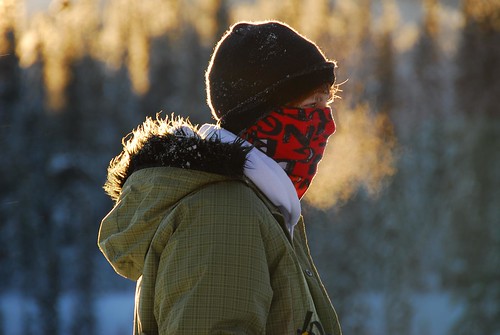 As residents of the DC area know well, warm air can hold more moisture than cold air can -- thus our humid summer days and (relatively) dry winter days. Your breath is warm and moist, just like a 98 degree summer day in DC. When that warm, moist breath hits the much cooler air of winter, the water vapor condenses into tiny water droplets.
As residents of the DC area know well, warm air can hold more moisture than cold air can -- thus our humid summer days and (relatively) dry winter days. Your breath is warm and moist, just like a 98 degree summer day in DC. When that warm, moist breath hits the much cooler air of winter, the water vapor condenses into tiny water droplets. There's not a specific temperature at which you can see your breath -- it depends on how much moisture is already in the air. On more humid days, you'll be able to see your breath at a warmer temperature.
Adults often think of seeing our breath as proof of just how miserably cold it is outside. But there are other ways to think of it. Just hang out with kids who still think it's exciting to see their breath (remember?). Or take the opportunity to reflect on the way your breath is connected to all other beings on the planet. In The Lost Gospel of the Earth
We are all breathing the same air our ancestors did, the same air as those with whom we think we share nothing in common. We breathe through nature. The air we breathe is generated and maintained by trillions of active organisms, from bacteria and termites to flowers and redwoods. I breathe in oxygen and breathe out carbon dioxide; the trees in my yard give oxygen to us and receive the carbon dioxide...We all breathe individually, but there is only one breathing process going on. When I look at photos of the thin cradle of atmosphere around the planet earth, I am seeing the breath of life.Look for your breath, indeed.
Like the photo in this post? Mouse over for credits; a click takes you to the photographer on Flickr.
Tuesday, December 8, 2009
Bookshelf: Noteworthy Books About Nature in 2009
Whether you're looking for a holiday present, or just looking for a good book to read, here are some books on nature and the environment that caught our attention in 2009.
What's the best nature-oriented book you read this year? Leave us a comment!
 Where the Wild Things Were: Life, Death, and Ecological Wreckage in a Land of Vanishing Predators
Where the Wild Things Were: Life, Death, and Ecological Wreckage in a Land of Vanishing Predators
by William Stolzenburg (paperback, 304 pages)
Stolzenburg examines the critical role of predators in this highly-praised book. Predators are "keystone species" essential to biodiversity, and disasters can happen when they are removed from an ecosystem. Included among the examples in this book are the prolific white-tailed deer of Eastern forests, who are stripping undergrowth and destroying flora in our area because there are no longer wolves and cougars to keep them in check.
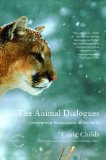 The Animal Dialogues: Uncommon Encounters in the Wild
The Animal Dialogues: Uncommon Encounters in the Wild
by Craig Childs (paperback, 352 pages)
In this book of first-person essays, Childs tells of his many encounters with animals, from mountain lions and grizzly bears to hummingbirds and red-spotted toads. Publisher's Weekly calls the essays "hauntingly beautiful": "Seeking entrée into animal societies, he interprets messages left in marks on the ground and in scents on leaves and trees, and communicates with animals directly using their own language of stares, gestures, postures, sounds, scents and gaits."
 Built by Animals: The Natural History of Animal Architecture
Built by Animals: The Natural History of Animal Architecture
by Mike Hansell (paperback, 280 pages)
This book explores the complex structures that animals build, including bird nests, butterfly pupae, caddis larvae traps, beaver dams, and more. Hansell asks, how do creatures with such small brains achieve these impressive feats of engineering? The answers are explored through the results of scientific investigations on social structures, the biochemistry and mechanics of materials, and the impact of these structures on the larger ecosystem.
 One Square Inch of Silence: One Man's Search for Natural Silence in a Noisy World
One Square Inch of Silence: One Man's Search for Natural Silence in a Noisy World
by Gordon Hempton and John Grossman (hardcover, 368 pages)
This book chronicles Hempton's travels from Seattle to Washington, D.C., in an attempt to find natural silence: a spot with "no audible human noise intrusions of any kind for a minimum of 15 minutes." Along the way, he discusses topics such as the decline in songbird populations, the effects of noise stress on both animals and humans, and the basics of audio science. He argues: "If a loud noise... can affect many square miles, then a natural place, if maintained in a 100 percent noise-free condition, will likewise affect many square miles around it.".
 American Earth: Environmental Writing Since Thoreau
American Earth: Environmental Writing Since Thoreau
Ed. by Bill McKibben (hardcover, 900 pages)
In his introduction to this anthology, McKibben argues that "environmental writing is America's most distinctive contribution to the world's literature." He goes on to present the work of 101 American writers chronologically, from Henry David Thoreau and John Muir to contemporary writers including Terry Tempest Williams, Barbara Kingsolver, Michael Pollan, and Paul Hawken. At 900 pages, there's a lot to chew on here.
 Dawn Light: Dancing with Cranes and Other Ways to Start the Day
Dawn Light: Dancing with Cranes and Other Ways to Start the Day
by Diane Ackerman (hardcover, 256 pages)
Ackerman launches each essay in this collection with the fresh start of a sunrise and launches into explorations of nature, mythology, and life -- especially life, and the need to live in the moment. A review in the Washington Post called it "glorious prose, studded with arresting phrases and breathtakingly beautiful images," with "sections that employ the precision of a naturalist and scientist to convey the wonder of a poet."
 Paradise Found: Nature in America at the Time of Discovery
Paradise Found: Nature in America at the Time of Discovery
by Steve Nicholls (hardcover, 536 pages)
"We have diminished nature far more than most people know." writes Nicholls. In a book he refers to as a "time machine," he sets out to describe just how abundant the natural world was in America before European settlement. From vast herds of buffalo, to flocks of carrier pigeons that blackened the sky, to fish so thick in the water that observers said they could have crossed a river without touching bottom, Nicholls draws on the accounts of explorers and settlers to document all that has been lost since those early Europeans first arrived.
If you're looking to read these books yourself, consider conserving resources by checking your local library for a copy. If you're gift shopping, we'll get a small percentage of the purchase price if you purchase from Amazon through one of the links in this post.
What's the best nature-oriented book you read this year? Leave us a comment!
 Where the Wild Things Were: Life, Death, and Ecological Wreckage in a Land of Vanishing Predators
Where the Wild Things Were: Life, Death, and Ecological Wreckage in a Land of Vanishing Predatorsby William Stolzenburg (paperback, 304 pages)
Stolzenburg examines the critical role of predators in this highly-praised book. Predators are "keystone species" essential to biodiversity, and disasters can happen when they are removed from an ecosystem. Included among the examples in this book are the prolific white-tailed deer of Eastern forests, who are stripping undergrowth and destroying flora in our area because there are no longer wolves and cougars to keep them in check.
 The Animal Dialogues: Uncommon Encounters in the Wild
The Animal Dialogues: Uncommon Encounters in the Wildby Craig Childs (paperback, 352 pages)
In this book of first-person essays, Childs tells of his many encounters with animals, from mountain lions and grizzly bears to hummingbirds and red-spotted toads. Publisher's Weekly calls the essays "hauntingly beautiful": "Seeking entrée into animal societies, he interprets messages left in marks on the ground and in scents on leaves and trees, and communicates with animals directly using their own language of stares, gestures, postures, sounds, scents and gaits."
 Built by Animals: The Natural History of Animal Architecture
Built by Animals: The Natural History of Animal Architectureby Mike Hansell (paperback, 280 pages)
This book explores the complex structures that animals build, including bird nests, butterfly pupae, caddis larvae traps, beaver dams, and more. Hansell asks, how do creatures with such small brains achieve these impressive feats of engineering? The answers are explored through the results of scientific investigations on social structures, the biochemistry and mechanics of materials, and the impact of these structures on the larger ecosystem.
 One Square Inch of Silence: One Man's Search for Natural Silence in a Noisy World
One Square Inch of Silence: One Man's Search for Natural Silence in a Noisy Worldby Gordon Hempton and John Grossman (hardcover, 368 pages)
This book chronicles Hempton's travels from Seattle to Washington, D.C., in an attempt to find natural silence: a spot with "no audible human noise intrusions of any kind for a minimum of 15 minutes." Along the way, he discusses topics such as the decline in songbird populations, the effects of noise stress on both animals and humans, and the basics of audio science. He argues: "If a loud noise... can affect many square miles, then a natural place, if maintained in a 100 percent noise-free condition, will likewise affect many square miles around it.".
 American Earth: Environmental Writing Since Thoreau
American Earth: Environmental Writing Since ThoreauEd. by Bill McKibben (hardcover, 900 pages)
In his introduction to this anthology, McKibben argues that "environmental writing is America's most distinctive contribution to the world's literature." He goes on to present the work of 101 American writers chronologically, from Henry David Thoreau and John Muir to contemporary writers including Terry Tempest Williams, Barbara Kingsolver, Michael Pollan, and Paul Hawken. At 900 pages, there's a lot to chew on here.
 Dawn Light: Dancing with Cranes and Other Ways to Start the Day
Dawn Light: Dancing with Cranes and Other Ways to Start the Dayby Diane Ackerman (hardcover, 256 pages)
Ackerman launches each essay in this collection with the fresh start of a sunrise and launches into explorations of nature, mythology, and life -- especially life, and the need to live in the moment. A review in the Washington Post called it "glorious prose, studded with arresting phrases and breathtakingly beautiful images," with "sections that employ the precision of a naturalist and scientist to convey the wonder of a poet."
 Paradise Found: Nature in America at the Time of Discovery
Paradise Found: Nature in America at the Time of Discoveryby Steve Nicholls (hardcover, 536 pages)
"We have diminished nature far more than most people know." writes Nicholls. In a book he refers to as a "time machine," he sets out to describe just how abundant the natural world was in America before European settlement. From vast herds of buffalo, to flocks of carrier pigeons that blackened the sky, to fish so thick in the water that observers said they could have crossed a river without touching bottom, Nicholls draws on the accounts of explorers and settlers to document all that has been lost since those early Europeans first arrived.
If you're looking to read these books yourself, consider conserving resources by checking your local library for a copy. If you're gift shopping, we'll get a small percentage of the purchase price if you purchase from Amazon through one of the links in this post.
Monday, December 7, 2009
Natural Happenings: Kids Activities This Week
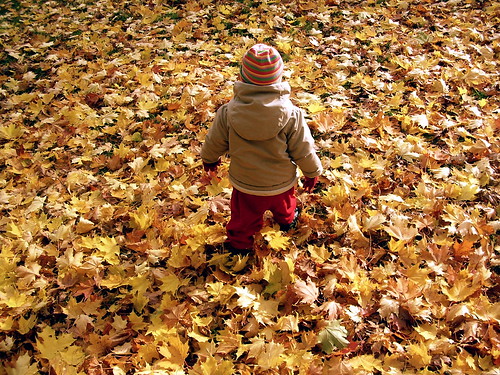
Sure, we've got lots of hikes on our calendar. But we don't often highlight the numerous events for kids that we put up there as well.
Monday: Make holiday crafts at Huntley Meadows in the afternoon. (Ages 6-8, $5, registration required.)
Tuesday: The Museum of Natural History has a program every week in their soil exhibit called "Dig It!" with hands-on activities for kids.
Wednesday. Huntley Meadows has another holiday craft session, this one for ages 3-5, in the morning. The planetarium at Rock Creek Park has an afternoon program aimed at ages 4+ (no registration required), and Long Branch Nature Center has an after-school activity to learn about snow and make snow globes (ages 6-10, $5, registration required).
Thursday. Huntley Meadows has another holiday craft session (ages 3-5) in the morning. Thursday afternoon in Rock Creek Park, there's a short hike aimed at kids to look at the forest in winter (ages 5+). Or stop by Gulf Branch Nature Center in Arlington, where they'll be having "Christmas for the Animals," with stories for ages 5-9 and decorating and outdoor tree with treats for the birds.
Friday. Actually, one event really inspired this week's whole theme. I loved Woody Woodpecker as a kid. On Friday morning at 9:30, at the Locust Grove Nature Center in Bethesda, they'll show Woody Woodpecker cartoons, to be followed by a short hike. Maybe you'll even spot a pileated woodpecker. Advance registration is required - it's $2. (ages 2+)
On Friday night, there will be a walk at Locust Grove to listen for owls (ages 6+). Or stop by Long Branch Nature Center to look for flying squirrels (all ages, advance registration required, $5).
Saturday. Saturday morning, head to Locust Grove to learn about birds and make a birdfeeder (ages 6+). Or head to the Audubon Naturalist Society for a craft activity making holiday decorations that "highlight the colors, textures, and smells of nature" (Ages 5+, $15-18). Registration is required for both events.
Sunday. On Sunday afternoon, a Rock Creek Park ranger will lead a hike to Milkhouse Ford (ages 7+).
Both Saturday and Sunday. The Rock Creek Park planetarium will have multiple programs on both Saturday and Sunday. And the Long Branch Nature Center program on flying squirrels repeats on Saturday and Sunday evenings.
Perhaps most enticing for parents, on both Saturday and Sunday, parents can drop their kids (ages 4-14) at Long Branch from noon to 4:00 for nature-themed activities, for just $20. Advance registration is required.
Of course there are lots of hikes and programs aimed at adults on our weekly calendar. We'll see you out there!
Like the photo in this post? Mouse over for credits; a click takes you to the photographer on Flickr.
Friday, December 4, 2009
Is The Giving Tree an Environmentalist Book?
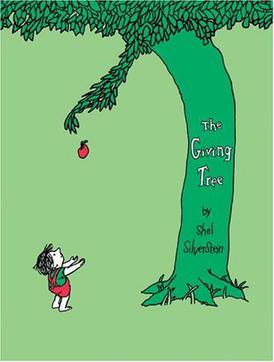 I loved Shel Silverstein's The Giving Tree
I loved Shel Silverstein's The Giving TreeFor those of you who need a refresher, the basic premise of the story is this: a tree and a little boy are best friends. As the boy grows up, he's no longer interested in playing with the tree. Trying to make the boy happy, the tree gives more and more of herself (her branches to build a house, her trunk to build a boat), until the boy (now a man) has chopped her down to a stump. In the end, the boy comes back as an old man, needing a place to sit and rest -- and then, finally, both he and the tree are really happy again.
Reading this book as an adult, it's clear to me that Silverstein is trying to convey the sense that material things don't make you happy. Seeking wealth and belongings just keeps the boy coming back for more. The only times he is really satisfied are when he's playing or sitting with the tree, enjoying their friendship. That is a good environmental message: more relationships, less stuff.
I do think that message may get through to kids a little. At least on a more simplistic level, one four year old remembered it to me as "the book about the boy and the tree that are best friends." That was probably my first take-away message as well: you can befriend the natural world. Another good message for kids.
And yet, I can't get over this: the boy cuts down an entire tree. And the tree asks him to do it, thinking she'll make him happy. I can't help worrying that this plants somewhere in kids' minds the idea that it might be ok to cut down trees. Not good. (Feminists also note stereotypical gender roles: the tree is female, reinforcing the idea that women give everything and men just take. Also bad.)
My solution? At least at the toddler level, I've been keeping a running commentary. "Oh, how sad! The tree doesn't have any branches anymore!" "It seems like that didn't really make the boy happy, did it?" That kind of thing. Maybe that will let me keep reading one of my favorite books from childhood.
Thursday, December 3, 2009
LOOK FOR: Persimmon, Fruit of the Gods
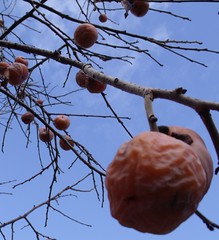 I have a very early (and not entirely pleasant) childhood memory of getting pelted with persimmons as my mother shook them out of a tree in the woods near our house. Sometime in my twenties I overcame this trauma, and now I am likely to be the one shaking them town. Their scientific name says it all -- Diospyros virginiana, the Virginian food of the gods.
I have a very early (and not entirely pleasant) childhood memory of getting pelted with persimmons as my mother shook them out of a tree in the woods near our house. Sometime in my twenties I overcame this trauma, and now I am likely to be the one shaking them town. Their scientific name says it all -- Diospyros virginiana, the Virginian food of the gods. Persimmons have come up with an ingenious method for protecting themselves until they're fully ripe: they are horribly, mouth-puckeringly astringent when immature. There is a common saying (among folks who eat persimmons, at least) that a frost makes persimmons lose this astringency. This is close, but not exactly true: persimmons ripen up around the time of our first frost, but the two events aren't related. We've found edible persimmons before a frost, and horribly astringent ones after frost.
 The real rule of thumb is that you only want to eat fruit that are gooey-soft and falling off the tree. Give the trunk a gentle shake and collect the fruits that fall. (Beware any fruit that are still attached to a twig when they fall: they weren't actually ready to come down yet.) Before you eat a whole fruit, take a small bite and wait a minute to make sure it's not going to make your mouth feel like it's been sucked dry: the puckering power of the persimmon is definitely related to how much you've eaten. You can take home close-but-not-quite-ripe fruits and let them continue ripening indoors for a week or two. But don't let all this talk of astringency scare you off: when they're good, they're really, really good.
The real rule of thumb is that you only want to eat fruit that are gooey-soft and falling off the tree. Give the trunk a gentle shake and collect the fruits that fall. (Beware any fruit that are still attached to a twig when they fall: they weren't actually ready to come down yet.) Before you eat a whole fruit, take a small bite and wait a minute to make sure it's not going to make your mouth feel like it's been sucked dry: the puckering power of the persimmon is definitely related to how much you've eaten. You can take home close-but-not-quite-ripe fruits and let them continue ripening indoors for a week or two. But don't let all this talk of astringency scare you off: when they're good, they're really, really good.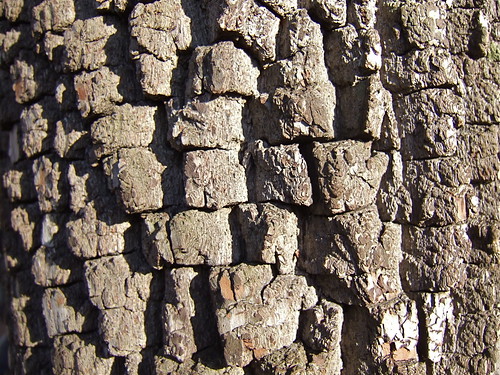 At this time of year, you have two ways of identifying a persimmon tree: by bark, and by fruit. The bark is dark grey and chunky, broken up into squares. Learning to recognize it is key, because the fruits are usually well above eye level. When you see the bark, look up: the fruits are round and orange, about the size of a golf ball, hanging on the tree long after it has lost its leaves. Each fruit has a distinctive four-part sepal on top. There's nothing I can think of that you could confuse them with. So, shake away!
At this time of year, you have two ways of identifying a persimmon tree: by bark, and by fruit. The bark is dark grey and chunky, broken up into squares. Learning to recognize it is key, because the fruits are usually well above eye level. When you see the bark, look up: the fruits are round and orange, about the size of a golf ball, hanging on the tree long after it has lost its leaves. Each fruit has a distinctive four-part sepal on top. There's nothing I can think of that you could confuse them with. So, shake away!In the wild: Persimmons need sun to set a lot of fruit. You'll often see them on the edges of woods. We know of a few on the C&O Canal between Great Falls Tavern and the falls, and many along the Northwest Branch of the Anacostia north of Colesville Road. And we always keep an eye out for fruit along Eastern Avenue at Jecquie Park in Takoma, where there's a tall persimmon right next to the sidewalk.
In your yard: Persimmons can grow in a wide range of soils. You'll need sun, and room for a tree that will eventually be 20 feet or more. Edible Landscaping has a selection of saplings grafted from trees found in the wild with unusually large fruits. They appear to have also grafted them to be self-fertile, which is important, because wild persimmons have male and female trees.
Do you have a persimmon story, or a favorite spot where you find persimmons? Leave us a comment!
Like the photos in this post? Mouse over for credits; a click takes you to the photographer on Flickr.
Tuesday, December 1, 2009
Rainy Day Nature: the National Aquarium in DC
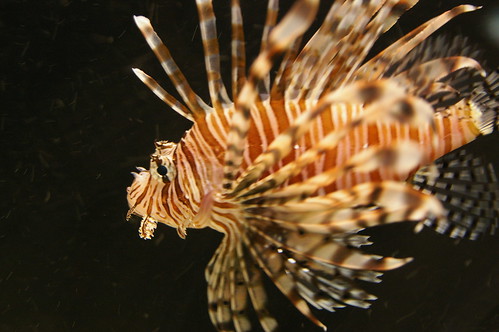 Did you know there's an aquarium just off the mall, on 14th St.? Sure, it's nothing near the size of the Baltimore Aquarium. But it's closer, cheaper, and much less crowded.
Did you know there's an aquarium just off the mall, on 14th St.? Sure, it's nothing near the size of the Baltimore Aquarium. But it's closer, cheaper, and much less crowded. The 250+ species at the National Aquarium are organized by ecosystem, highlighting the National Marine Sanctuaries of the US, major freshwater rivers, and the Amazon River. Highlights include alligators, beautiful tropical fish, pirahnas, some small sharks, poison dart frogs, and an invasive snakehead. Feedings are at 2:00 every day.
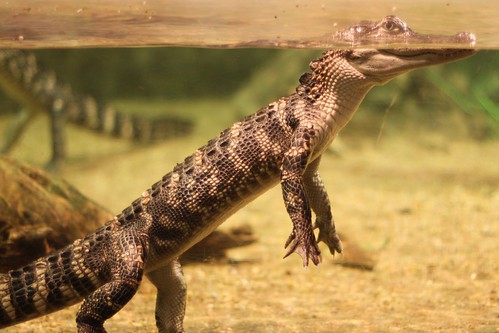 The National Aquarium started in 1878 in some lakes by the Washington Monument. It moved around the Mall a few times until landing in the basement of the Commerce Building (then home of the Bureau of Fisheries) in 1932. In 1982, they lost their federal funding, and there have been some lean years. But in 2003, the aquarium affiliated with the Baltimore Aquarium, and they've since undergone a multi-million-dollar face-lift. It's definitely an improvement. So if you haven't been in a while, it might be worth another visit.
The National Aquarium started in 1878 in some lakes by the Washington Monument. It moved around the Mall a few times until landing in the basement of the Commerce Building (then home of the Bureau of Fisheries) in 1932. In 1982, they lost their federal funding, and there have been some lean years. But in 2003, the aquarium affiliated with the Baltimore Aquarium, and they've since undergone a multi-million-dollar face-lift. It's definitely an improvement. So if you haven't been in a while, it might be worth another visit. 
Hours: daily 9 AM to 5 PM (last admission at 4:30), except Christmas and Thanksgiving Day
Admission:
$7 for ages 11 and up
$3 ages 2-10
$6 seniors and military
Public Transportation: Federal Triangle is the closest metro station.
National Aquarium
14th and Constitution Avenue, NW
Washington, DC 20230
Like the photos in this post? Mouse over for credits; a click takes you to the photographer on Flickr.
Monday, November 30, 2009
Natural Happenings: Winter Evenings
As the nights grow longer, we need things to do in the dark. Here are a few natural night-time activities that caught our eye for this week:
One of the most popular activities at the National Arboretum is their monthly full moon hikes. A guide will lead you on a four-mile walk through the arboretum grounds from 7:00 to 9:00 PM. This month's walks are on this Tuesday, Wednesday, and Thursday, Dec. 1-3. Advance registration is required, and last I checked, Thursday's hike was already full. (It's not too early to sign up for January or February!) $22 ($18 for Friends of the National Arboretum).
The Conservatory of the US Botanic Garden on the Mall will stay open until 8:00 PM on several Tuesdays and Thursdays throughout December. And they'll have live music starting at 6:00 PM. Up this week: harps and singing on Tuesday night, and a cappella singing on Thursday. If you can't stand Christmas music, your best bet might be next Tuesday, December 10, when they'll have a klezmer band called Lox and Vodka. The full schedule is here. Free.
Map geeks may want to check out a lecture in observation of the 125th anniversary of the US Geological Survey topographic mapping program on Wednesday at 7:00 PM at USGS headquarters in Reston. Mark DeMulder will "highlight elements of the colorful history of the program and describe the future of topographic mapping at the USGS." Bring a photo ID since it's in a federal office building. Free.
As always, we've got a full schedule of daytime activities up on our calendar as well. See you out there!
Like the photo in this post? Mouse over for credits; a click takes you to the photographer on Flickr.
One of the most popular activities at the National Arboretum is their monthly full moon hikes. A guide will lead you on a four-mile walk through the arboretum grounds from 7:00 to 9:00 PM. This month's walks are on this Tuesday, Wednesday, and Thursday, Dec. 1-3. Advance registration is required, and last I checked, Thursday's hike was already full. (It's not too early to sign up for January or February!) $22 ($18 for Friends of the National Arboretum).
The Conservatory of the US Botanic Garden on the Mall will stay open until 8:00 PM on several Tuesdays and Thursdays throughout December. And they'll have live music starting at 6:00 PM. Up this week: harps and singing on Tuesday night, and a cappella singing on Thursday. If you can't stand Christmas music, your best bet might be next Tuesday, December 10, when they'll have a klezmer band called Lox and Vodka. The full schedule is here. Free.
Map geeks may want to check out a lecture in observation of the 125th anniversary of the US Geological Survey topographic mapping program on Wednesday at 7:00 PM at USGS headquarters in Reston. Mark DeMulder will "highlight elements of the colorful history of the program and describe the future of topographic mapping at the USGS." Bring a photo ID since it's in a federal office building. Free.
As always, we've got a full schedule of daytime activities up on our calendar as well. See you out there!
Like the photo in this post? Mouse over for credits; a click takes you to the photographer on Flickr.
Thursday, November 26, 2009
Happy Thanksgiving!
Hope you have a nice time with friends and family. We'll be back on Monday!
Meanwhile, check out these Thanksgiving-related posts:
- Turkey Run Park
- wild turkeys
- giving thanks for natural capital and the ecosystem services it provides
- hikes on and after Thanskgiving
Vintage Thanksgiving postcard from this great collection on Flickr.
Tuesday, November 24, 2009
Natural Places in the DC Area To Take Your Out-of-Town Visitors
If you're like us, you've got company coming for Thanksgiving. Some ideas on where to take your guests, for Thanksgiving or at any other time of the year:
Great Falls has always been our default guest-taking spot. There's really nothing like it in the DC area. The views of the falls are great from either side, though the Washington City Paper dubbed Cow Hoof Rock, on the Virginia side, as the best view of the Potomac last year. You have a choice of gentle trails (like the C&O Canal towpath in MD or the Swamp Trail in VA), or rugged trails (like the Billy Goat Trail in MD), for your guests to choose from. $5 admission.
Several Natural Capital readers said they take their guests to the National Arboretum. There's so much to choose from -- everything from very natural-looking and un-manicured Fern Valley, to an indoor bonsai exhibit with trees that have been maintained for hundreds of years. Plus the old Capital columns arranged to look like a Greek temple are a treat for architecture and history buffs. The grounds are open every day from 8 to 5, but the bonsai exhibit is closed on Thanksgiving Day and open on other days only from 10 to 4, so plan accordingly. Free.
If you're going to be down on the Mall, make a detour from all the museums to the US Botanic Garden. Even if you just pop in for a few minutes to see the orchid exhibit, your guests will be impressed. Plus, starting on Thanksgiving, they have a toy train that goes through landscapes and buildings made of sticks, seeds, and other plant-based materials, along with a giant Christmas tree and lots of poinsettias. Free.
Thanksgiving bonus: Take 'em to Turkey Run. Not just for the name -- though that's while we suggest it -- but because it's a pretty spot on the Potomac, where you'll have to climb hills. And we suspect you'll have a few extra calories you'll be wanting to work off this weekend. Free.
Great Falls has always been our default guest-taking spot. There's really nothing like it in the DC area. The views of the falls are great from either side, though the Washington City Paper dubbed Cow Hoof Rock, on the Virginia side, as the best view of the Potomac last year. You have a choice of gentle trails (like the C&O Canal towpath in MD or the Swamp Trail in VA), or rugged trails (like the Billy Goat Trail in MD), for your guests to choose from. $5 admission.
Several Natural Capital readers said they take their guests to the National Arboretum. There's so much to choose from -- everything from very natural-looking and un-manicured Fern Valley, to an indoor bonsai exhibit with trees that have been maintained for hundreds of years. Plus the old Capital columns arranged to look like a Greek temple are a treat for architecture and history buffs. The grounds are open every day from 8 to 5, but the bonsai exhibit is closed on Thanksgiving Day and open on other days only from 10 to 4, so plan accordingly. Free.
If you're going to be down on the Mall, make a detour from all the museums to the US Botanic Garden. Even if you just pop in for a few minutes to see the orchid exhibit, your guests will be impressed. Plus, starting on Thanksgiving, they have a toy train that goes through landscapes and buildings made of sticks, seeds, and other plant-based materials, along with a giant Christmas tree and lots of poinsettias. Free.
Thanksgiving bonus: Take 'em to Turkey Run. Not just for the name -- though that's while we suggest it -- but because it's a pretty spot on the Potomac, where you'll have to climb hills. And we suspect you'll have a few extra calories you'll be wanting to work off this weekend. Free.
Monday, November 23, 2009
Natural Happenings: Burn the Bird
 Most of us will be overeating on Thanksgiving. Good thing our calendar includes lots of options for working off some of those extra calories. Many trips offer carpool options, so you can get out on the trail even if you don't have a car. No excuses!
Most of us will be overeating on Thanksgiving. Good thing our calendar includes lots of options for working off some of those extra calories. Many trips offer carpool options, so you can get out on the trail even if you don't have a car. No excuses!Turkey Day: If you prefer to burn your calories before you consume them, there are two hikes scheduled for Thursday morning. The Center Hiking Club is heading to Sky Meadows to hike 7 miles, including a stretch of the Appalachian Trail. Some of them will be getting together for Thanksgiving dinner afterwards. The DC Metropolitan Hikers are going to Patapsco Valley State Park for an 8 mile hike.
Friday: The Nature Lovers Meetup is taking a 4 mile hike at Great Falls in the morning. The Capital Hiking Club will be there in the evening for a moonlight hike.
Saturday: You can head out with the Sierra Club for an 11 mile hike through Difficult Run, in Reston. Or join the Capital Hiking Club for 9 miles on the Potomac Heritage Trail and the C&O Canal. Register by Wednesday to hike 8 miles on Sugarloaf Mountain with Washington Women Outdoors. Or, if you want to go even farther afield, the Center Hiking Club and the North Virginia Hiking Club are both headed to Shenandoah National Park.
Sunday: The Center Hiking Club will hike 10 miles on the Ridge and Valley Trails in Rock Creek Park. The North Virginia Hiking Club will cover 5-6 miles in Occoquan Regional Park. The Wanderbirds head up toward Frederick for 8-11 miles at Catoctin Mountain Park and Cunningham Falls. The Sierra Club is going to Harper's Ferry for a 7 mile hike at Maryland Heights, and another delegation from the Center Hiking Club is headed to hike Old Rag.
Check our calendar for details on any of these hikes. We'll see you out there!
Like the photo in this post? Mouse over for credits; a click takes you to the photographer on Flickr.
Friday, November 20, 2009
Giving Thanks, or, What Has Your Ecosystem Done For You Lately?
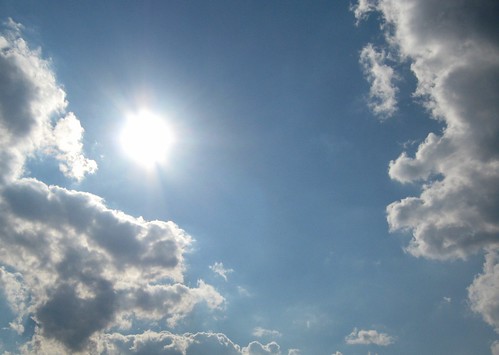 I've been reading the book Natural Capitalism
I've been reading the book Natural Capitalism Natural capital can be viewed as the sum total of the ecological systems that support life, different from human-made capital in that natural capital cannot be produced by human activity. It is easy to overlook because it is the pond in which we swim, and, like fish, we are not aware we're in the water. One can live perfectly well without ever giving a thought to the sulfur cycle, mycorrhizal formation, alleles, wetland functions, or why giant sequoia trees can't reproduce without chattering squirrels...Only when the services provided by ecosystem functions are unmistakably disrupted do we step back and reconsider.
Natural capital can be viewed as the sum total of the ecological systems that support life, different from human-made capital in that natural capital cannot be produced by human activity. It is easy to overlook because it is the pond in which we swim, and, like fish, we are not aware we're in the water. One can live perfectly well without ever giving a thought to the sulfur cycle, mycorrhizal formation, alleles, wetland functions, or why giant sequoia trees can't reproduce without chattering squirrels...Only when the services provided by ecosystem functions are unmistakably disrupted do we step back and reconsider.So, let's step back and consider. Consider the things that the ecosystem you live in is doing for you today, and every day of your life:
- Air to breathe: producing oxygen, purifying air, and regulating the chemical composition of the atmosphere.
- Water to drink: storage, cycling, purification, and distribution of fresh water.
- Food to eat: converting solar energy into food; recycling nutrients and maintaining soil fertility.
- Materials to use: converting solar energy into raw materials; providing a genetic library for food, fibers, pharmaceuticals, and other materials.
- A place to live: managing flooding and soil erosion; regulating the local and global climate; protection against harmful cosmic radiation.

What are you thankful for? Leave us a comment!
Like the photos in this post? Mouse over for credits; a click takes you to the photographer on Flickr.
Thursday, November 19, 2009
LOOK FOR: Wild Turkeys
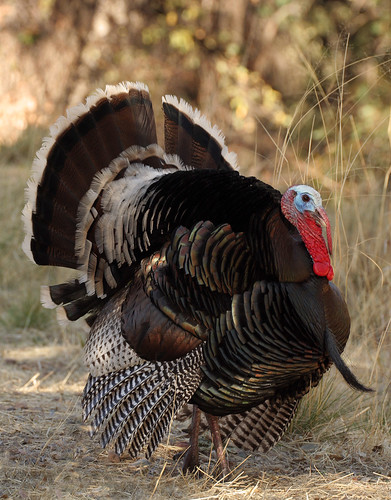 It's almost Thanksgiving, and everybody's thinking of turkey. But long before Thanksgiving existed, turkeys were here in North America.
It's almost Thanksgiving, and everybody's thinking of turkey. But long before Thanksgiving existed, turkeys were here in North America.Turkeys are among the largest birds in our area, with a wingspan over 4 feet and weighing up to 24 pounds. The stereotypical Thanksgiving pose -- tailfeathers fanned out, feathers fluffed up -- is a display that males put on to attract mates, but also when they feel threatened. Not so surprising, then, that this is our picture of turkeys at Thanksgiving time.
As another display tactic, male turkeys have featherless heads that can be bright blue during mating season, complemented by bright red throat, wattles (the floppy part under the beak), snoods (a flap that dangles over the beak), and caruncles (other red growths around the neck and head. Males also have a curious tuft of hairs coming out of the middle of their chests called a beard. If he puts on a successful show, each male typically maintains a harem of several females. Meanwhile, the females can get away with being smaller and less colorful -- in fact, they need to be, as they're the ones that tend the nests.

By the early 1900's, turkey populations in North America had been decimated by hunting. But wildlife managment programs have made a concerted effort to bring the bird back through habitat protection and re-introduction of birds where they had disappeared. For example, the Maryland Department of Natural Resources estimates that the wild turkey population in Maryland has rebounded from about 2,000 turkeys in two or three counties in 1973, to over 30,000 birds in 2008, with wild turkeys in every Maryland county.
In the wild: Turkeys are found throughout Maryland and Virginia in a variety of habitats. In the summer, they seek out areas with berries, grasses, and insects, including both woods and meadows. In the fall and winter, they may increase the time they spend in the woods as they seek out acorns. Many of the times that we have seen wild turkeys have been along rivers; they tend to nest within a few hundred yards of water.
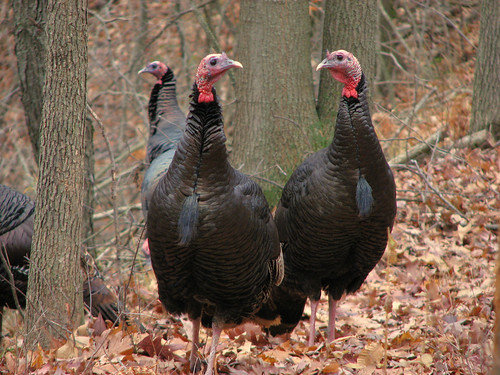 In your yard: Wild turkeys have been known to stray into more urban and suburban areas occasionally, but in general, they're very wary of people. (We have to wonder, though, whether domesticated turkeys will get in on the urban poultry phenomenon at some point.)
In your yard: Wild turkeys have been known to stray into more urban and suburban areas occasionally, but in general, they're very wary of people. (We have to wonder, though, whether domesticated turkeys will get in on the urban poultry phenomenon at some point.)More info:
An excellent report from the Maryland DNR: The Wild Turkey in Maryland
Sounds of Wild Turkeys from the National Wild Turkey Foundation
Like the photos in this post? Mouse over for credits; a click takes you to the photographer on Flickr.
Tuesday, November 17, 2009
Turkey Run Park
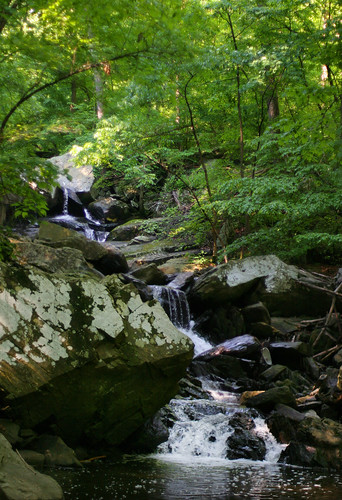 I hate to admit it, but for several years, my main familiarity with Turkey Run was as a spot to turn around when I missed a turn-off on the GW Parkway. It's a shame, because it's a great park, with 700 acres and almost 3 miles of shoreline along the Potomac. We feature it this week in honor of the upcoming Thanksgiving holiday.
I hate to admit it, but for several years, my main familiarity with Turkey Run was as a spot to turn around when I missed a turn-off on the GW Parkway. It's a shame, because it's a great park, with 700 acres and almost 3 miles of shoreline along the Potomac. We feature it this week in honor of the upcoming Thanksgiving holiday.Not surprisingly, since it's just down the river, the topography of Turkey Run is very similar to that of Scott's Run. You'll drop down from upland woods into the rich bottomland flood plain of the Potomac River. And when I say "drop," I mean drop...nearly 200 feet over about a quarter mile of trail. It makes for lovely streams tumbling down to the Potomac...and a tough climb back up.
In the spring, Turkey Run Park is full of wildflowers, especially bluebells along the Potomac. In the fall, it's time to catch the turning leaves. And, once leaves are down, to catch better views of the river.
 You have three good options for loop hikes at Turkey Run. All start by heading down the steep switchback trail that leaves from Parking Lot C:
You have three good options for loop hikes at Turkey Run. All start by heading down the steep switchback trail that leaves from Parking Lot C:- The shortest option is to go left along the Potomac, then follow Turkey Run back uphill and cross over to the parking lot (see the yellow trail on this map). This can be extended by walking along the Potomac and then doubling back. Total hike is only about a mile, but it will feel like more since it's all up and down.
- At the bottom of the switchbacks, if you go to the left, it's about a mile to the next stream, which is called Dead Run. Follow Dead Run uphill and follow these directions to get back to the parking lot. Total hike is 3.9 miles.
- At the bottom of the switchbacks, go right, and hike along the Potomac until you reach the Woods Trail (see the green and pink trails on this map). This will take you up the hill, past Parking Lots A and B, and back to Parking Lot C. Total hike is about 3 miles.
 Other info:
Other info:The entrance to Turkey Run is about 2 miles inside the Beltway (exit 43) on the GW Parkway. It's not accessible by public transportation as far as we can tell.
The park is free and open sunrise to sunset, every day. There are picnic tables, restrooms, and water fountains near the parking lots.
Bikes are not allowed.
Dogs are allowed, but must remain on leash.
Turkey Run Park
McLean, VA, 22101
(703)289-2500
Like the photos in this post? Mouse over for credits; a click takes you to the photographer on Flickr.
Monday, November 16, 2009
Natural Happenings: Looking Up
Did you know the Air and Space Museum has a new 16-inch, 3,000-pound Boller and Chivens telescope on loan from Harvard College Observatory? It will be open to the public on Tuesday night from 5:30 to 7:30. Afterward, stay for the lecture about the Hubble Space Telescope by astronaut John Grunsfeld in the Lockheed Martin IMAX Theater. Free tickets are required for the lecture, but not the telescope.
Still looking up, but a little closer to the ground, there are lots of opportunities to go birding on our calendar every week. For the coming week:
See you out there!
Like the photo in this post? It's by Flickr user CarbonNYC..
Still looking up, but a little closer to the ground, there are lots of opportunities to go birding on our calendar every week. For the coming week:
- The Nature Lover's Meetup has scheduled a Birding and Beer outing to Riverbend Park and Old Brogue pub on Saturday afternoon/evening.
- The Audubon Naturalist Society has several free birding trips on Saturday: an all-day trip to Eastern Neck National Wildlife Refuge, a half day trip to Charles County, and a short morning birding class at their sanctuary in Chevy Chase. On Sunday, there's a paid field trip to Eastern Neck.
- The Prince George's County Audubon Society goes to Lake Artemesia first and third Thursdays at 3:00 PM and first and third Saturdays at 7:30 AM in Bowie (see below).
- The Northern Virginia Audubon Society goes to Huntley Meadows Mondays at 7:00 AM, Dyke Marsh Sundays at 8:00 AM, and Great Falls Sundays at 8:00 AM.
See you out there!
Like the photo in this post? It's by Flickr user CarbonNYC..
Friday, November 13, 2009
Where is Your Favorite Natural Spot to Take Guests?
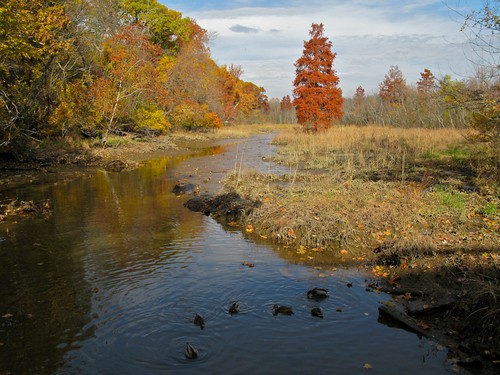 We've got family coming for Thanksgiving. They love to hike (they raised us well). And, since they've been visiting us in the DC area for many years, we've taken them to all our favorite hiking spots. So we thought we'd throw the question out there to you: what's your favorite place to take out-of-town guests at this time of year? We'll round up your answers (and our own) in a post in time for Thanksgiving.
We've got family coming for Thanksgiving. They love to hike (they raised us well). And, since they've been visiting us in the DC area for many years, we've taken them to all our favorite hiking spots. So we thought we'd throw the question out there to you: what's your favorite place to take out-of-town guests at this time of year? We'll round up your answers (and our own) in a post in time for Thanksgiving. Photo of Roosevelt Island on Thanksgiving 2007 is by Michael Foley Photography; click to go to his page on Flickr.
Thursday, November 12, 2009
LOOK FOR: White Throated Sparrows, Back for the Winter
 A few weeks ago, we started seeing white throated sparrows in our yard again. These little birds breed in Canada during the summer, then head south to spend the winter anywhere from Pennsylvania south to Florida, and west to Missouri and Texas.
A few weeks ago, we started seeing white throated sparrows in our yard again. These little birds breed in Canada during the summer, then head south to spend the winter anywhere from Pennsylvania south to Florida, and west to Missouri and Texas.White throated sparrows often hop around on the ground and forage in the leaf litter, where most of their plumage serves as good camouflage. But their head markings stand out, and lend the bird its scientific name, Zonotrichia albicollis: stripe-headed white-throat. These birds do indeed have white throats, often with a thin, dark border. The stripes on top of the head come in two color variations: either black and white or brown and tan. But perhaps most distinctive is the little patch of yellow just above and in front of the eye (a "lore"). This yellow patch stands out to me so much that this, and not the white throat, is usually how I recognize these birds for who they are.
Some people say the song of the white-throated sparrow sounds like they're saying "Oh sweet Canada, Canada, Canada." I find that helps me remember what bird I'm hearing more than the other mnemonic often used for their song: "Poor Sam Peabody, Peabody, Peabody." Anybody could say that (though I'm not sure why Sam Peabody is so deserving of pity). No, these little guys are clearly longing for their summer home. Have a listen:
 In the wild: like many birds, white-throated sparrows like the edges of woods, and suburban backyards. In the winter they eat seeds from grasses and ragweed to grape, rose, and dogwood.
In the wild: like many birds, white-throated sparrows like the edges of woods, and suburban backyards. In the winter they eat seeds from grasses and ragweed to grape, rose, and dogwood.In your yard: White throated sparrows will come to feeders, especially for millet and black oil sunflower seeds, but they prefer to eat the seed scattered on the ground. You can make an area extra-inviting by providing cover (like a brush pile or thicket) and water in a birdbath, pond, or fountain.
Like the photos in this post? Mouse over for credits; a click takes you to the photographer on Flickr.
Wednesday, November 11, 2009
A Week of Links: Busy at Work and Play Edition
We've both been really busy this week...so a few less links than usual, unless you want to read about the work Elizabeth's been doing for the Kaiser Family Foundation (along with several other projects that don't have results yet). But you're here for nature, not the complicated world of Medicare Part D. And we've got some for you:
- Natural ringtones: make your phone ring with bird calls, or animal sounds from the National Zoo.
- And speaking of the National Zoo, here's video of a recent deer vs. lions incident. Are zoo lions so weakened by captivity that they can't decisively take out a deer that strays into their enclosure? And are deer now so overpopulated in Rock Creek Park that they are actively seeking out predators?
- There's a hearing on the Purple Line coming up on Dec. 10. It's a dilemma for nature lovers: do you make the Capital Crescent trail less nice in order to get more cars off the road?
- Lovely pictures of the leaves in Klingle Valley from Valerie Hinojosa.
- Bringing Nature Home to Your Ecosystem Garden: a podcast with author Doug Tallamy.
- How's this for bringing nature into your home? An article from the New York Times home & garden section on Building With Whole Trees.
Autumn is a second spring when every leaf is a flower. - Albert Camus
Tuesday, November 10, 2009
Rainy Day Nature: The Conservatory of the US Botanic Garden
 When I worked on the Mall, the Conservatory of the US Botanic Garden was a key part of my winter survival strategy. If you need a fix of green growing things, or of warm, steamy air, this is your place.
When I worked on the Mall, the Conservatory of the US Botanic Garden was a key part of my winter survival strategy. If you need a fix of green growing things, or of warm, steamy air, this is your place.At any given time, there are about 4,000 plants on display in these Botanic Garden greenhouses. A major highlight for me is the orchid room. Hundreds of orchids are on display at any given time, rotated in and out according to what's blooming. (The USBG's entire collection includes about 5,000 orchids.) What an amazing display of the wonders of evolution. Be sure to smell as well as look -- the white orchids are more likely to have stronger fragrance.
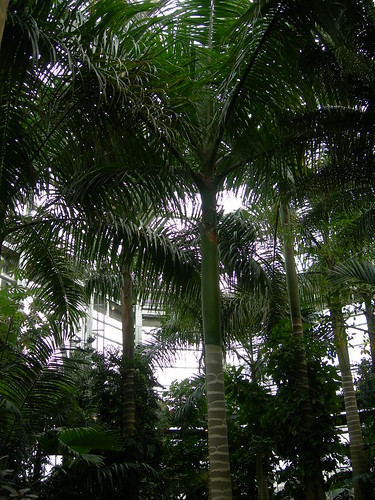 In the center of the Botanic Garden, under a 93 foot dome, is a display in which jungle plants are "overtaking an abandoned plantation." You can walk through the ground floor, or climb up to a balcony that views the canopy of these plants. Keep an eye out for bananas!
In the center of the Botanic Garden, under a 93 foot dome, is a display in which jungle plants are "overtaking an abandoned plantation." You can walk through the ground floor, or climb up to a balcony that views the canopy of these plants. Keep an eye out for bananas!Other sections of the greenhouses reconstruct other environments. One room contains a reconstructed Jurassic landscape of ferns and other ancient plants. Another highlights cacti, succulents, and other flora from deserts around the world. A Hawaii room shows off plants from that tropical paradise. (Do you see why I find this place restorative in the winter?)
For those looking for a human connection, other displays highlight the uses of specific plants: as medicines, and as fibers, food, cosmetics, and other economic goods. And there is an exhibit on the role of plants in culture.
 The human history of the garden itself is also interesting. Apparently, George Washington, Thomas Jefferson, and James Madison all participated in calls to have a national botanic garden. One was established on the Mall in 1820, and this one has been in continuous operation since 1850. The current structure dates to 1933, and is under the jurisdiction of the Architect of the Capitol -- making the Botanic Garden part of the Legislative Branch.
The human history of the garden itself is also interesting. Apparently, George Washington, Thomas Jefferson, and James Madison all participated in calls to have a national botanic garden. One was established on the Mall in 1820, and this one has been in continuous operation since 1850. The current structure dates to 1933, and is under the jurisdiction of the Architect of the Capitol -- making the Botanic Garden part of the Legislative Branch. Admission to all public areas of the U.S. Botanic Garden is free. The Conservatory is open 10 AM to 5 PM daily, including weekends and holidays, with free tours on Mondays and Thursdays at noon. The closest metro is Federal Center SW.
US Botanic Garden
100 Maryland Avenue, SW
Washington, DC 20001
Like the photos in this post? Mouse over for credits; a click takes you to the photographer on Flickr.
Subscribe to:
Posts (Atom)

